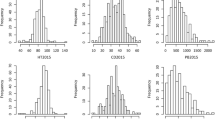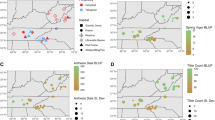Abstract
Switchgrass (Panicum virgatum L.) has two ecotypes that are genetically and phenotypically distinct: upland and lowland. Furthermore, the upland ecotype has two distinct cytological races: tetraploid and octoploid. This study was undertaken to determine if there is a difference between the tetraploid and octoploid cytotypes of the upland ecotype for biomass yield. The study utilized data from 15 published studies, including 145 field trials and 446 trial-years of data for which a tetraploid vs. octoploid statistical comparison was possible. Of the 145 trials, 34 showed a statistical advantage of octoploid over tetraploid, averaging 34% for these trials, compared to 11% over all 145 trials. Octoploids tended to be more responsive to favorable environments, with a significantly higher linear response to increasing mean biomass yield. The octoploid cytotype is more common across the natural landscape and within germplasm collections aimed at breeding new cultivars. Furthermore, formal selection and breeding of switchgrass has been ongoing for longer at the octoploid level compared to the tetraploid level. Thus, the biomass yield advantage of octoploid switchgrass compared to the tetraploids, for the upland ecotype, is more likely an anthropogenic phenomenon, resulting from historically larger population sizes, greater collection activity, and more long-term selection pressures.



Similar content being viewed by others
Data availability
Data are available from published literature as cited or by contacting the author.
References
Ainouche ML, Fortune PM, Salmon A, Parisod C, Grandbastien MA, Fukunaga K, Ricou M, Misset MT (2009) Hybridization, polyploidy and invasion: lessons from Spartina (Poaceae). Biol Invasions 11:1159–1173
Barnett FL, Carver RF (1967) Meiosis and pollen stainability in switchgrass. Panicum Virgatum Crop Sci 7:301–304
Berdahl JD, Frank AB, Krupinsky JM, Carr PM, Hanson JD, Johnson HA (2005) Biomass yield, phenology, and survival of diverse switchgrass cultivars and experimental strains in western North Dakota. Agron J 97:549–555
Brunken JN, Estes JR (1975) Cytological and morphological variation in Panicum virgatum L. Southwestern Nat 19:379–385
Casler MD (2005) Ecotypic variation among switchgrass populations from the northern USA. Crop Sci 45:388–398
Casler MD (2012) Switchgrass breeding, genetics, and genomics. In: Monti A (ed) Switchgrass. Springer, New York, pp 29–54
Casler MD (2020) Selection for flowering time as a mechanism to increase biomass yield of upland switchgrass. BioEnergy Res 13:100–108
Casler MD (2022) Nitrogen fertilization and harvest management of switchgrass impacts on biomass yield and nitrogen removal. BioEnergy Res. https://doi.org/10.1007/s12155-022-10435-z
Casler MD, Boe AR (2003) Cultivar x environment interactions in switchgrass. Crop Sci 43:2226–2233
Casler MD, Smart AJ (2013) Plant mortality and natural selection may increase biomass yield in switchgrass swards. Crop Sci 53:500–506
Casler MD, Vogel KP (2014) Selection for biomass yield in upland, lowland, and hybrid switchgrass. Crop Sci 54:626–636
Casler MD, Vogel KP, Beal AC (2006) Registration of WS4U and WS8U switchgrass germplasms. Crop Sci 46:998–999
Casler MD, Vogel KP, Taliaferro CM, Ehlke NJ, Berdahl JD, Brummer EC, Kallenbach RL, West CP, Mitchell RB (2007) Latitudinal and longitudinal adaptation of switchgrass populations. Crop Sci 47:2249–2260
Casler MD, Vogel KP, Harrison M (2015) Switchgrass germplasm resources. Crop Sci 55:2463–2478
Casler MD, Sosa S, Hoffman L, Mayton H, Ernst C, Adler PR, Boe AR, Bonos SA (2017) Biomass yield of switchgrass cultivars under high- versus low-input conditions. Crop Sci 57:821–832
Casler MD, Vogel KP, Lee DK, Mitchell RB, Adler PR, Sulc RM, Johnson KD, Kallenbach RL, Boe AR, Mathison RD, Cassida KA, Min DH, Crawford J, Moore KJ (2018) 30 Years of progress toward increasing biomass yield of switchgrass and big bluestem. Crop Sci 58:1242–1254
Dunbier MW, Eskew DL, Bingham ET, Schrader LE (1975) Performance of genetically compatible diploid and tetraploid alfalfa: agronomic and physiological parameters. Crop Sci 15:211–214
Feuerstein U, Paul C (1991) On the designed development of tetraploid annual ryegrass varieties. Polyploidy and chromosome manipulation in forage breeding (Veronesi F et al., eds) p 23–28.
Frank AB, Berdahl JD, Hanson JD, Leibig MA, Johnson HA (2004) Biomass and carbon partitioning in switchgrass. Crop Sci 44:1391–1396
Godfree RC, Marshall DJ, Young AG, Miller CH, Matthews S (2017) Empirical evidence of fixed and homeostatic patterns of polyploid advantage in a keystone grass exposed to drought and heat stress. Royal Soc Open Sci 4:170934
Hahn MA, van Kleunen M, Müller-Schärer H (2012) Increased phenotypic plasticity to climate may have boosted the invasion success of polyploid Centaurea stoebe. PLoS ONE 7:e50284
Hopkins AA, Vogel KP, Moore KJ, Johnson KD, Carlson IT (1995) Genotype effects and genotype by environment interactions for traits of elite switchgrass populations. Crop Sci 35:125–132
Hopkins AA, Taliaferro CM, Murphy CD, Christian D (1996) Chromosome numbers and nuclear DNA content of several switchgrass populations. Crop Sci 36:1192–1195
Humphreys MO (1991) The value of polyploidy in breeding hybrid grasses. Polyploidy and chromosome manipulation in forage breeding (Veronesi F et al., eds) p 37–44.
Jacobson ET, Tober DA, Haas RJ, Darris DC (1984) The performance of selected cultivars of warm season grasses in the northern prairie and plains states. In: Proceedings 9th North Amer Prairie Conference. p 215–221.
Lee DK, Boe AR (2005) Biomass production of switchgrass in central South Dakota. Crop Sci 45:2583–2590
Lee JM, Matthew C, Thom ER, Chapman DF (2012) Perennial ryegrass breeding in New Zealand: a dairy industry perspective. Crop Pasture Sci 63:107–127
Levy AA, Feldman M (2002) The impact of polyploidy on grass genome evolution. Plant Physiol 130:1587–1593
Littell RC, Milliken GA, Stroup WW, Wolfinger RD (1996) SAS system for mixed models. SAS Institute, Inc., NC
Lovell J et al (2021) Multiple genomic paths to climate adaptation in the biofuel crop switchgrass. Nature. https://doi.org/10.1038/s41586-020-03127-1
Madakadze IC, Coulman BE, Peterson P, Stewart KA, Samson R, Smith DL (1998) Leaf area development, light interception, and yield among switchgrass populations in a short-season area. Crop Sci 38:827–834
Martinez-Reyna JM, Vogel KP, Caha C, Lee DJ (2001) Meiotic stability, chloroplast DNA polymorphisms, and morphological traits of upland x lowland switchgrass reciprocal hybrids. Crop Sci 41:1579–1583
Paterson AH (2005) Polyploidy, evolutionary opportunity, and crop adaptation. Genetica 123:191–196
Petit C, Thompson JD (1997) Variation in phenotypic response to light availability between diploid and tetraploid populations of the perennial grass Arrhenatherum elatius from open and woodland sites. J Ecol 85:657–667
Rauf S, Ortiz R, Malinowski DP, Clarindo WR, Kainat W, Shehzad M, Waheed U, Hassan SW (2021) Induced polyploidy: a tool for forage species improvement. Agriculture 11:210
Riley RD, Vogel KP (1982) Chromosome numbers of released cultivars of switchgrass, indiangrass, big bluestem, and sand bluestem. Crop Sci 22:1082–1083
Rose LW IV, Das MK, Fuentes RG, Taliaferro CM (2007) Effects of high- vs. low-yield environments on selection for increased biomass yield in switchgrass. Euphytica 156:407–415
Rothera SL, Davy AJ (1986) Polyploidy and habitat differentiation in Deschampsia caespitosa. New Phytol 102:449–467
Sattler MC, Carvalho CR, Clarindo WR (2016) The polyploidy and its key role in plant breeding. Planta 243:281–296
Serapiglia MJ, Boateng AA, Lee DK, Casler MD (2016) Switchgrass harvest time management can impact biomass yield and nutrient content. Crop Sci 56:1970–1980
Sladden SE, Bransby DI, Aiken GE (1991) Biomass yield, composition, and production costs for eight switchgrass varieties in Alabama. Biomass Bioenergy 1:119–122
Smith KF, McFarlane NM, Croft VM, Trigg PJ, Kearney GA (2003) The effects of ploidy and seed mass on the emergence and early vigour of perennial ryegrass (Lolim perenne L.) cultivars. Aust J Exp Agric 43:481–486
Stebbins GL (1985) Polyploidization, hybridization, and the invasion of new habitats. Ann Missouri Bot Garden 72:824–832
Stebbins GL (1980) Polyploidy in plants: unsolved problems and prospects. Polyploidy, Biological Relevance (Lewis WH, ed) Plenum Press, NY. p 495–520.
Steel RGD, Torrie JH, Dickey DA (1996) Principles and procedures of statistics: a biometrical approach, 3rd edn. McGraw-Hill, New York
Stewart A, Hayes R (2011) Ryegrass breeding—balancing trait priorities. Irish J Agric Food Res 50:31–46
Udall JA, Wendell JF (2006) Polyploidy and crop improvement. Plant. Genome 1:S3–S14
Vogel KP, Hendrickson J (2018) History of grass breeding for grazing lands in the Northern Great Plains of the USA and Canada. Rangelands 41:1–16
Vogel KP (2004) Switchgrass. Warm-season (C4) grasses (Moser LE et al., eds) ASA-CSSA-SSSA, Madison, WI. p 561–588.
Wilkins PW (1991) Breeding perennial ryegrass for agriculture. Euphytica 52:201–214
Wilkins PW, Lovatt JA (2011) Gains in dry matter yield and herbage quality from breeding perennial ryegrass. Irish J Agric Food Res 50:23–30
Zhang Y, Zalapa J, Jakubowski AR, Price DL, Acharya A, Wei Y, Brummer EC, Kaeppler SM, Casler MD (2011a) Natural hybrids and gene flow between upland and lowland switchgrass. Crop Sci 51:2626–2641
Zhang Y, Zalapa J, Jakubowski AR, Price DL, Acharya A, Wei Y, Brummer EC, Kaeppler SM, Casler MD (2011b) Post-glacial evolution of Panicum virgatum: Centers of diversity and gene pools revealed by SSR markers and cpDNA sequences. Genetica 139:933–948
Funding
This work was conducted while the author was employed by the U.S. Department of Agriculture and funding was by congressional allocation.
Author information
Authors and Affiliations
Corresponding author
Ethics declarations
Conflict of interest
The author declares no conflict of interest.
Additional information
Publisher's Note
Springer Nature remains neutral with regard to jurisdictional claims in published maps and institutional affiliations.
Rights and permissions
Springer Nature or its licensor (e.g. a society or other partner) holds exclusive rights to this article under a publishing agreement with the author(s) or other rightsholder(s); author self-archiving of the accepted manuscript version of this article is solely governed by the terms of such publishing agreement and applicable law.
About this article
Cite this article
Casler, M.D. Impact of ploidy on biomass yield of upland switchgrass (Panicum virgatum L.) : a meta-analysis. Genet Resour Crop Evol 70, 1115–1122 (2023). https://doi.org/10.1007/s10722-022-01489-1
Received:
Accepted:
Published:
Issue Date:
DOI: https://doi.org/10.1007/s10722-022-01489-1




